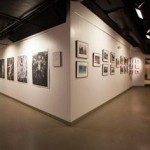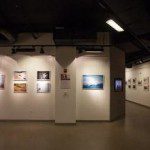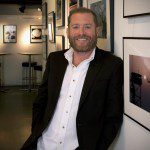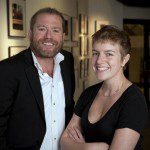With dizzying energy, Jack’s Boathouse owner Paul Simkin teaches students to move with the latest technology as the director of Boston University’s Center for Digital Imaging Arts, located in Georgetown. In his own way, he instructs them to stay current and focused on the big picture.
Because of the many media outlets in the nation’s capital and the digital media explosion, the center was established to meet the needs of 21st-century creatives. The center offers professional studies certificates in 3D animation, audio production, digital filmmaking, graphic and web design, digital photography and web development. The approximately 300 students enrolled in the programs are registered as full-time students or take classes at night as part-time students. The other programs include locations in Atlanta, Ga. and Waltham, Mass., west of Boston University’s main campus.
In addition to his work as a photography professional and educator, Simkin also manages and owns Jack’s Boathouse next to Key Bridge. Simkin, who bought the boathouse in 2006, rents out approximately 70,000 boats per year, he says. An avid kayaker, the Chicago native says the idea to buy the boathouse came to him while taking a conference call in the middle of the Potomac River.
As with anything in Georgetown, there is a historical context. Boston University’s CDIA D.C. campus is located in the Foundry building on Thomas Jefferson Street, in the space formerly occupied by the Foundry Cinema, which closed in 2002. The original Foundry building dates back to 1856.
The center’s spaces consist of administrative offices, computer labs and photo studios. Simkin’s office is on the ground level next to the C&O Canal, but the first thing you might notice is the skeleton that he uses as a coat rack. Equipment is everywhere. He has not yet fully moved in. One characteristic about Simkin is that he seems like he’s ready for anything.
“I can go anywhere in the world and shoot anything with that,” says Simkin, as he points to a pile of photography equipment.
Even though students pick one major on which to focus, multidisciplinary study is the name of the game.
“If you can show that you can put a site together, that you can put the illustration for your intention, whatever it is, you’re worth a million dollars to [people],” said Simkin. “It puts you light-years above all the other people of a similar ilk. That’s what we’re dedicated to.”
For Simkin, it is important to balance the practical and creative aspects.
“That creates a problem,” says Simkin, “because we aren’t teaching people to fix air conditioners and transmis- sions. We’re teaching art. So, on the one hand, we’re train- ing people to make money, but on the other hand we have to nurture a vision in someone.”
Instruction — and Structure
While at the center on Friday, Paul was approached by one of his students, Nouf Mallouh. She was working what the center calls her “Practicum.” Practicum is a student’s final project that requires them to provide work for non- profit, socially responsible organizations, which otherwise would not be able to afford such highly skilled digital work.
Mallouh is from Saudi Arabia. She’s studied both graphic design and photography at the center. For her practicum, she is working with the Literacy Lab, a non-profit organization that teaches reading to low-income students in Washington, D.C. She has a series of about 50 photos from a recent shoot
and wanted Simkin’s opinion.
As Mallouh goes through the photos, Simkin gives both positive and constructive criticism.
“Nice shot,” he says. “That’s a beautiful shot. Thank you. You’re very good at capturing faces. Take a compli- ment when you get it. She’s mugging for the camera. Next, please.”
Simkin gives Mallouh a lot of tips about where to crop photos but compliments her ability to capture faces and hands. After about 20 minutes, we leave the computer lab. Moments like those are what make the job for Simkin, who became director of the center in September. “One condition I made when I accepted the job was that I get to do stuff like that,” Simkin says.
As the center’s director, Simkin might not be expected to be as available to his students as he is and that he would leave that sort of work to professors.
“When they kick my ass like that, it makes me a better photographer,” Simkin says. “She had a very good sense of feeling, of kids. I freeze up around kids. I can’t just get in and be tight and be part of a scene. She has a natural incli- nation for that. So, I get to see a point of view that I would otherwise miss.”
“I really couldn’t imagine a better mentor,” says Erin Schaff, assistant director at CDIA’s D.C. campus, and who views Simkin as a great resource for photography students.
Schaff, who is from Red Hook in upstate N.Y., graduated from Kenyon College in May 2011 with a
B.A. in political science and came to Washington to pursue a career on Capitol Hill. After working in the office of Sen. Kirsten Gillibrand, D-N.Y., and other jobs, Schaff began working part-time at Jack’s Boat- house in June and fell in love with the river.
“I had a full-time job, and I quit to work for him full-time,” says Schaff of Simkin. “It was kind of a big leap for me, because everything was kind of stable. Everything was going very well in the direction I thought I wanted to be going. So, it was a big leap, but it has totally been worth it.”
As someone who runs two large operations, it is no surprise Simkin needs someone to help keep him organized. Schaff provides that structure.
Never Getting Old
Boston University began opening its three CDIA campuses as film photography was being replaced by digital as the de facto medium for professional photographers.
“When we started five to six years ago, it was the end of film,” Simkin says. “It was the end of the dark room. These folks had the vision to make great photographs but at the same time to realize the end was there — and that it was not a defeat. It was a great opportunity to make great art.”
The school was founded on the principle that technology is constantly changing. This means that the center’s curriculum is continually changing. The center’s classes resume in January.
“Two years in digital stuff is huge,” Simkin says. “So, if we just stuck to the same one [process], we’d be in big trouble.”
This dedication to technology has been a constant for Simkin. When he was 24 years old, he was work- ing as a photo editor at the Associated Press. Then, he made a decision about photography.
“I’m editing photos, when I see these dark room guys. These are guys in white jackets who would print photos,” Simkin says. “I ask one of these guys, who were about as old as I am now, ‘How much back- ground is there to being a dark room guy?’ It turns out that the guys were photographers earlier, and they had shot on 4 by 5, the kind of stuff you’d shoot Marilyn Monroe with in the ’50s and the ’60s. Those pictures were great. The quality was great. So, when the 35 millimeter [film] came out, they didn’t want to shoot 35 millimeter, because it was so small and the pictures were grainy. They held on to their 4-by-5 view of things, and then the world passed them by. And they were printing my pictures.”
“I made the decision I was never going to get old as it related to the image.”
Boston University’s Center for Digital Imaging Arts will be partnering with the Georgetowner for its
fourth annual photography contest. Email submissions to photography@georgetowner.com by Jan. 8. Winners will be honored at a Jan. 17 reception. For more information, visit www.Georgetowner.com.
- Philip Bermingham.







